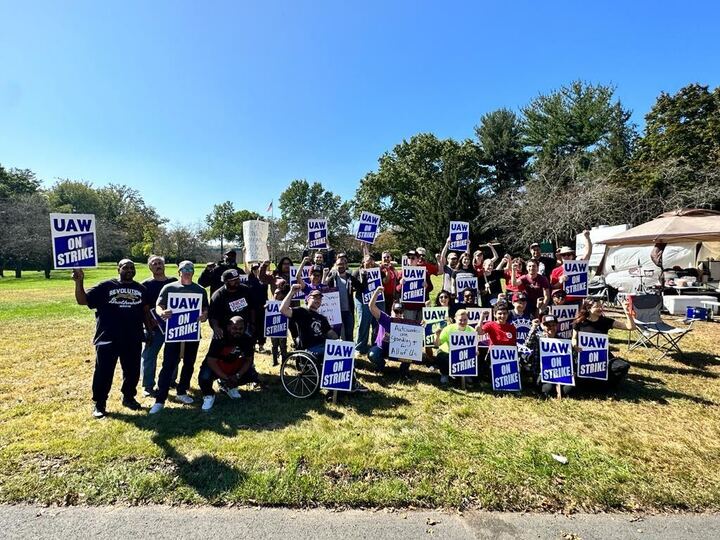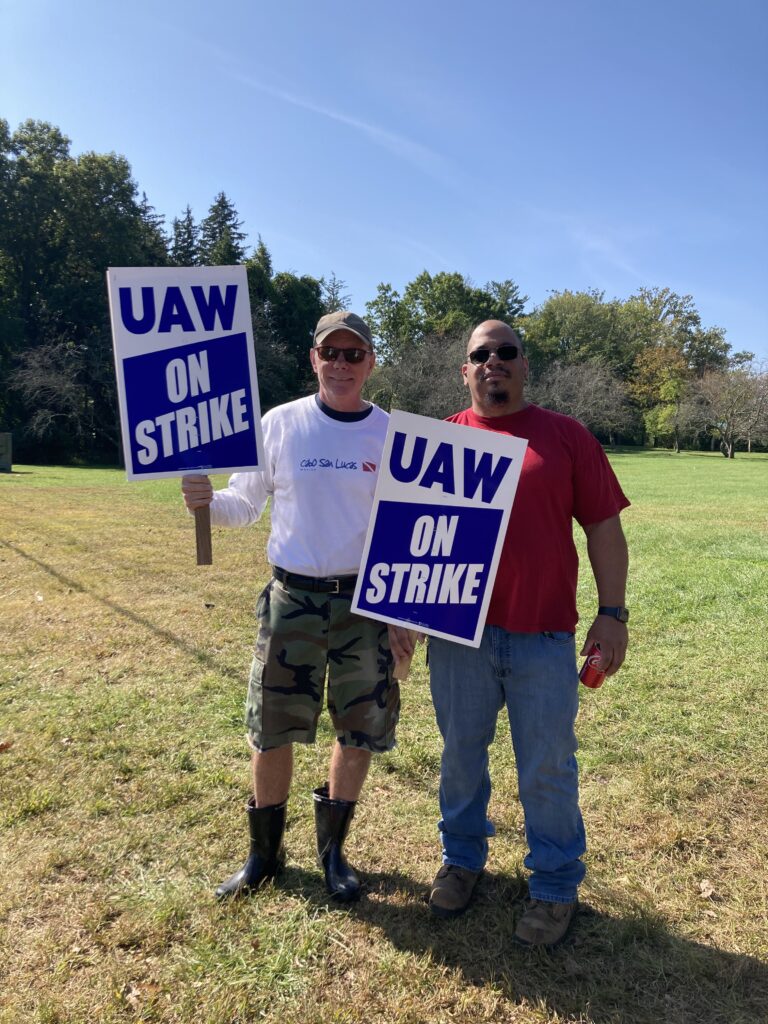Reports from UAW picket lines
Tappan, New York

Haley Pessin, October 1
About forty people showed up at any given time throughout the morning and afternoon on Sunday to stand alongside UAW Local 3039 autoworkers on strike outside the Chrysler parts distribution center in Tappan, NY.
After a week of heavy precipitation that subjected the lower part of New York State to 5-8 inches of rainfall and flash floods, the sunny, 77-degree weather proved perfect for walking a picket line.
In addition to the autoworkers, the crowd included community supporters, autoworkers’ friends and family, members of DSA chapters in the Hudson Valley and NYC, Left Voice (who came with drums to keep up the energy), and others. Drivers passing by the plant honked enthusiastically in support of the picket as workers handed out signs and hats that read, “Union Strong.” Workers also described the support they received from other unions, including UPS Teamsters, teachers, and others.

Importantly, with the exception of FedEx (which is not unionized), most delivery workers have strictly honored the picket line and refused to cross. So far, with few (if any) scabs, the workers have largely succeeded in shutting the plant down.
This solidarity matters a great deal, not only for bringing the plant’s operations to a standstill, but for sustaining a 24/7 picket. As one worker put it, “If you don’t have anything to do at 3 a.m., come join us!” The energy and confidence on the picket line also reflects hard work: the local has been preparing its members for the possibility of a strike for over a year, even before the election of new union leadership under UAWD-member Shawn Fain.
To get to the picket, I drove an hour north from NYC, along with four of my co-workers from the Legal Aid Society, which includes members of both UAW Local 2325 – Association of Legal Aid Attorneys (ALAA) and 1199 SEIU, and two workers from New York Legal Assistance Group (also members of ALAA). The drive itself was a rare opportunity to talk across our different unions and shops about our own ongoing contract fights and why winning the best contracts possible will require our unions to work together to organize more militant action in our workplaces.
Jeffrey Purcell, the President of UAW Local 3039, also spoke to this issue in an impromptu speech to the crowd of supporters. Wearing a Writers Guild of America t-shirt (whose recent strike ended in victory), Purcell noted why the significance of the strike goes beyond autoworkers:
A lot of unions have spoken to me, and members have spoken to me, and I said, you know what? You want better contracts, but your union is scared to go on strike. They’re scared to walk out. If we gotta be the ones to set the trend, to show everybody else [what’s possible], that’s what we’re gonna do.
The local also encouraged supporters to show solidarity by taking selfies and photos on the picket line and tagging @uaw.union.
Speakers: Local 3039 Vice President Dave Singh and Jeff Purcell, Local 3039 President. Video credit: Haley Pessin.
Mel Bienenfeld, October 2
When I arrived at the Tappan facility on Monday, there were four workers and no supporters there. At other times — especially weekends — NYC-DSA has gotten dozens of supporters to attend. There are fewer than one hundred workers at this facility, and to ensure the picket lines are staffed 24/7, the UAW local (covering this facility only) assigns picket duty only to a few at a time.
I asked to carry a sign and immediately the workers offered me water, soda, cookies, donuts, and coffee.
All of the picketers talked about the givebacks of 2008 and how the current wage demands are simply about catching up. They mentioned the companies’ huge profits. The tiers issue came up when one worker said that they were currently short-staffed because new hires are being offered only $15 an hour. They have been expected to make up for this by doing more work each. I asked one person about the “stand-up strike” strategy and he said it may be the right thing to do. He had not expected that parts plants would be called out the second week. (Some workers said that it appeared that a few trucks were able to be unloaded and re-loaded, implying some sort of scabbing, but it wasn’t clear).
I asked this person if he had voted for Fain and his answer was that he had not voted. He said that generally people there don’t follow what’s going on with the UAW nationally, though this person said that Fain had been part of the sellout of 2008 (I’m not sure that’s true) and may now be redeeming himself. There was strong awareness of the corruption at the top though – the same guy who said he didn’t follow things knew how many officers wound up in jail.

I asked if there was concern that people would lose their jobs in the transition to electric vehicles. One person said that it was not clear what would happen at the PDCs, but if the contract contained language mandating retraining for those losing their jobs, everyone there was smart enough to learn whatever skills were necessary to be placed elsewhere.
When I mentioned the widespread significance of this strike and the support it has received (easily evidenced by the honking horns of passing drivers) one guy suggested that what they were doing was likely to spread throughout labor – mentioning Las Vegas culinary workers! I had identified myself as from Tempest – wore the t-shirt – and there was no problem describing it as a socialist organization. (People thanked me when I gave the mag’s URL and my contact info.) I showed the quote on the back of the shirt to one guy and he was excited by it. When I told him where it was from he said, regarding communism, “The people who think something is a bad idea are those who don’t benefit from it”.
The plant supervisor of security stopped by and expressed strong support for the workers. So did a CSX railroad worker, who, still wearing his safety vest, drove up in his truck and unloaded several cases of water as a personal donation. “We had a contract shoved down our throat”, he said. “I hope what you all are doing gets you what you need.”
A crew from the Indypendent (NYC radical newspaper) showed up while I was there. They took notes for an article. The lead person was a member of their editorial board. I spoke at length to the other two members of the crew who seemed very interested in Tempest. They were just learning about labor issues. Somehow the rank-and-file strategy came up and they said that their lead reporter knew all about that. So I talked about Kim Moody, the DSA version, etc. I also had a whole conversation about labor since 1970 and they were quite interested. They were happy to exchange contact info with me and eager to check out our website.
Featured image credit: Laura Eraso; modified by Tempest.
Categories
We want to hear what you think. Contact us at editors@tempestmag.org. And if you've enjoyed what you've read, please consider donating to support our work:
DonateHaley Pessin and Mel Bienenfeld View All
Haley Pessin is a socialist activist living in Queens, New York and is a member of the Tempest Collective. They co-edited the book Voices of a People’s History of the United States in the 21st Century: Documents of Hope published by Seven Stories Press.
Mel Bienenfeld has been a socialist activist since the late 1960s. He belonged to the International Socialists in the 1970s and 1980s and was involved then in labor and anti-imperialist struggles. More recently he has been president of the Westchester Community College Federation of Teachers, retiring from that position in 2019
